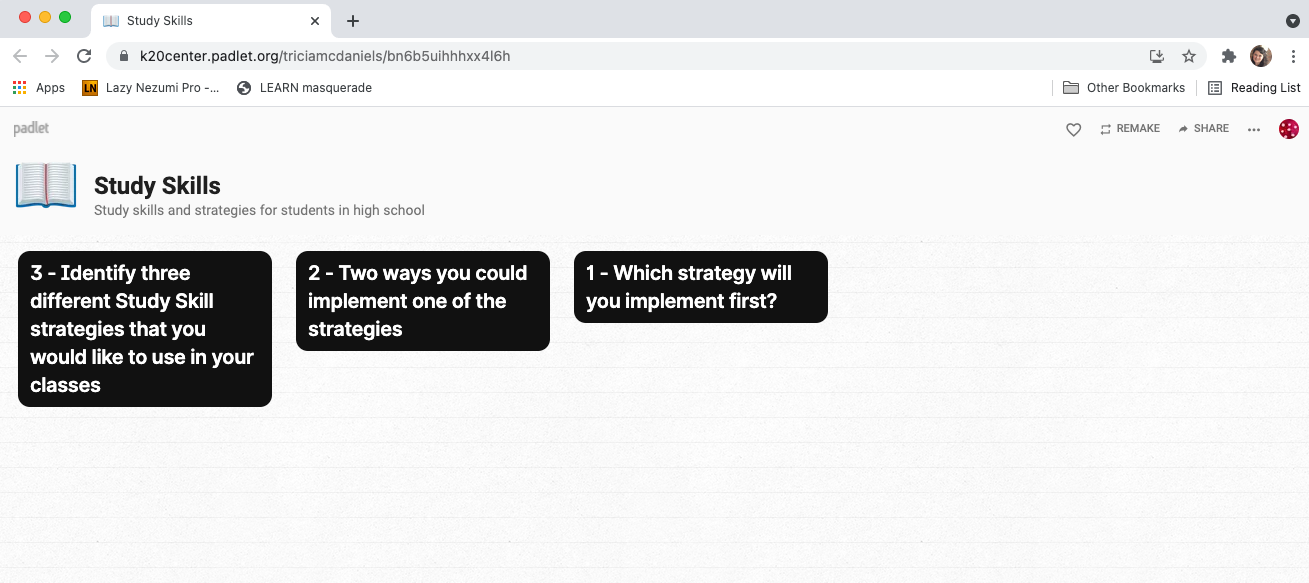Summary
This professional learning sessions focuses on providing teachers with foundational knowledge and strategies they can use to promote student autonomy. Participants will explore research on best practices for self-regulated learning, analyze learner motivation, reflect on personal teaching styles, and generate strategies for promoting student autonomy.
Essential Questions
How can students and teachers optimize self-productivity?
Materials List
Digital device
Internet connection
Study Skills and Strategies for Students in High School by Stephen Strichart or other comparable study skills resource
Presentation Slides
Writing utensils
Learning Goals
Analyze best practices for self-regulation
Generate strategies to promote and support student autonomy
Reflect on personal teaching styles and current classroom structures in a place that empowers student responsibility.
Engage
5 Minute(s)
Use the attached Presentation Slides to follow along with this PD. Go over the essential question on slide 3. Briefly discuss the objectives on slide 4.
To begin, invite learners to use the Justified List strategy to determine the top reasons people study and the top reasons people do not study. Explain to leaners that they will be choosing the top 3 reasons why people study and the top 3 reasons why people do not study from a given list of reasons. Display slide 5 with the Reasons People Don’t Study and Reasons People Do Study. Ask learners to decide what the top reasons are in both categories. Then, invite leaners to vote in the Mentimeter poll for what they think the top reason is for both lists. Move to slide 6 with the Mentimeter information. Allow time for learners to access the Mentimeter and to vote.
Display the Mentimeter results as a ranked list. Encourage a whole group discussion about the results. Invite learners to share why they chose the reasons they did.
Explore
10 Minute(s)
Move to slide 7. Distribute the Honeycomb Harvest activity via one of the following options:
Distribute a copy of the attached Study Skills Honeycomb Harvest handout to each learner.
Make the following link available to all learners: Study Skills Honeycomb Harvest activity (this link, also on slide 7, provides a separate copy for each learner.)
Be sure learners can access the activity before moving on.
Introduce learners to the Honeycomb Harvest strategy. For this activity, the statements in the “honeycomb” hexagons describe various aspects of self-regulated learning.
Ask learners to look at the statements and consider their relationships to one another. Learners should arrange the hexagons on the page in any combination that makes sense. Hexagons that touch each other should be somehow related to each other.
After individual learners have sorted the hexagons, ask them to pair up with another participant to discuss differences and similarities in how their study skills are arranged. Invite learners to share their reasoning with partners, explaining why the hexagons are arranged as they are.
Have each pair (or volunteers if it’s a very large session) share with the whole group something they sorted differently and summarize their discussion as partners.
Move to slide 8. After pairs or groups have shared out how they sorted the hexagons, ask them to consider this question: How would the use of the strategies from the Honeycomb Harvest address the reasons why learners do or do not study? Allow processing time, then ask for volunteers to share their answer to the question.
Explain
20 Minute(s)
Pass out a copy of the Best Practices: Self-Regulated Learning Research Brief to each learner. (Alternatively, you could provide the link to the research brief and learners could complete the activity within Google Docs.} Move to slide 9. Explain to learners that as they read the provided research brief, they will be completing a CUS and Discuss strategy. Briefly review the CUS and Discuss strategy with learners.
Circle references to strategies you saw in the Honeycomb Harvest activity
Underline any concepts you feel you could apply in your classroom
Star what stands out to you and that you would like to do but struggle envisioning how to implement in your classroom
Allow ample time for learners to read the research brief and to complete the CUS and Discuss strategy.
Extend
15 Minute(s)
Invite learners to explore the resources in the Study Skills and Strategies for Students in High School book. Allow learners time to identify strategies that they may use in their classrooms.
Using Padlet, learners will complete a 3-2-1 strategy to discuss the study skills they have explored. Share slide 10 and invite learners to go to the Padlet link or scan the QR code. Ask learners to answer the 3-2-1 prompts.
3 - Identify three different Study Skill strategies that you would like to use in your classes
2 - Two ways you could implement one of the strategies
1 - Which strategy will you implement first?

Briefly review responses.
Evaluate
10 Minute(s)
Pass out the Window Notes for Self-Regulation handout. (Alternatively, you could provide the link to the Window Notes for Self-Regulation handout and learners could complete using Google Docs.) Move to slide 11. Briefly review the Window Notes strategy.
Share with learners that they will now reflect on all the new information they have learned and explore how they feel about the information learned in the previous activities. Invite learners to answer each prompt focusing on their main takeaways, feelings, and inspirations for next steps.
Follow-Up Activities
Research Rationale
Read more about the research that guided this session in the attached Best Practices: Self-Regulated Learning Research Brief.
Resources
Cleary, T. J., & Zimmerman, B. J. (2004). Self-regulation empowerment program: A school-based program to enhance self-regulated and self-motivated cycles of student learning. Psychology in the Schools, 41(5), 537-550.
K20 Center. (n.d.). 3-2-1. Strategies. https://learn.k20center.ou.edu/strategy/117
K20 Center. (n.d.). CUS and Discuss. Strategies. https://learn.k20center.ou.edu/strategy/162
K20 Center. (n.d.). Honeycomb Harvest. Strategies. https://learn.k20center.ou.edu/strategy/61
K20 Center. (n.d.). Justified List. Strategies. https://learn.k20center.ou.edu/strategy/164
K20 Center. (n.d.). Window Notes. Strategies. https://learn.k20center.ou.edu/strategy/189
Schunk, D. H. (1983). Ability versus effort attributional feedback: Differential effects on self-efficacy and achievement. Journal of Educational Psychology, 75(6), 848.
Schunk, D. H., & Zimmerman, B. J. (1994). Self regulation of learning and performance: Issues and educational applications. Hillsdale, NJ: Lawrence Erlbaum.
Schunk, D. H., & Zimmerman, B. J. (Eds.). (1998). Self-regulated learning: From teaching to self-reflective practice. Guilford Press.
Strichart, S. S. (2019). Study Skills and Strategies for Students in High School. Mangrum-Strichart Learning Resources.
University of Connecticut (UCONN). (n.d.). Common regulation strategies. The National Research Center on the Gifted and Talented. Retrieved from https://nrcgt.uconn.edu/underachievement_study/self-regulation/sr_section7/
Zimmerman, B. J. (2000). Attaining self-regulation: A social cognitive perspective. In Handbook of self-regulation (pp. 13-39). Academic Press.
Zimmerman, B. J., & Bandura, A. (1994). Impact of self-regulatory influences on writing course attainment. American Educational Research Journal, 31(4), 845-862.
Zimmerman, B. J., & Campillo, M. (2003). Motivating self-regulated problem solvers. The Psychology of Problem Solving, 233262.


